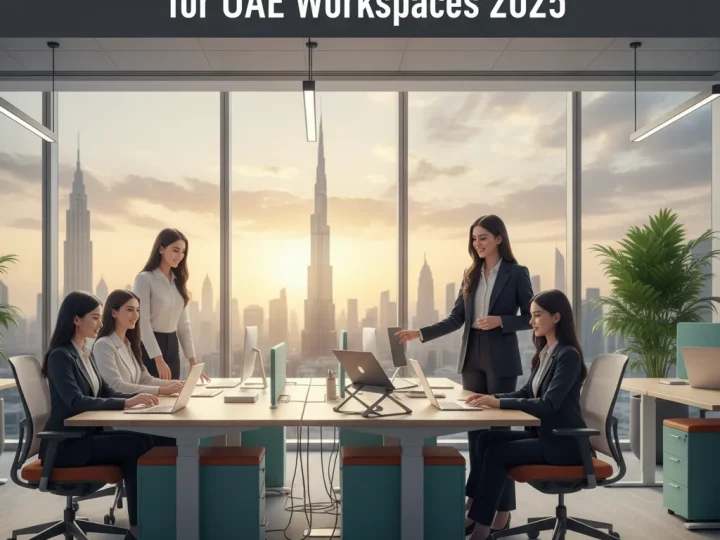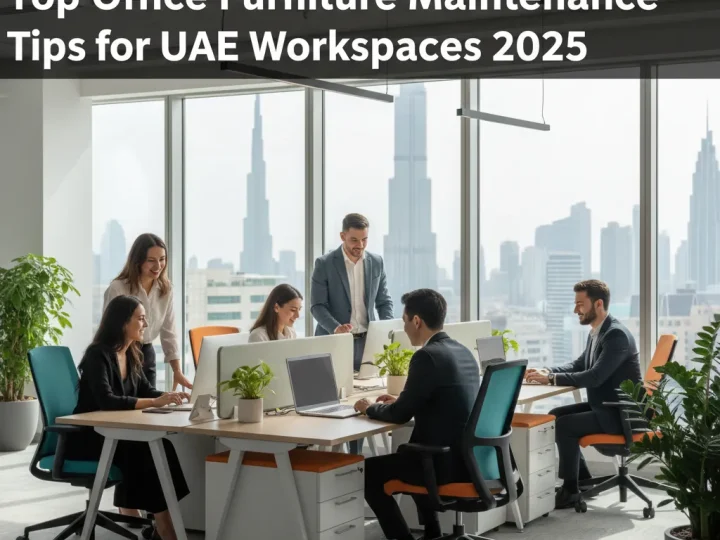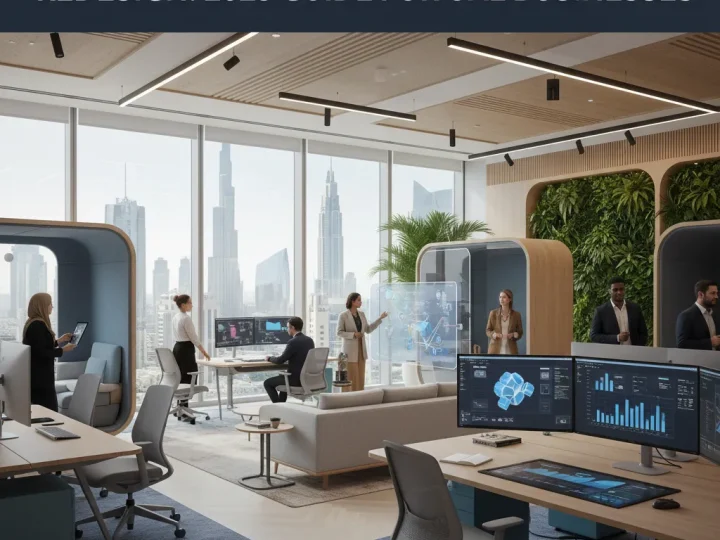Office interior design isn’t just about pretty spaces—it’s about crafting environments that ignite productivity and enhance employee wellbeing. In fact, studies show that well-designed workspaces can boost productivity by as much as 20 percent. But here’s the kicker: while most people focus on aesthetics, the true power lies in the details. Thoughtful elements like lighting, color, and layout can significantly influence mood and performance. Dive into this topic and discover how to transform your office into a powerhouse of innovation and collaboration.
Understanding Office Interior Design
Office interior design is far more than just arranging furniture in a workspace. It’s a strategic approach to creating environments that nurture productivity, reflect company culture, and support employee wellbeing. In today’s competitive business landscape, thoughtfully designed office spaces have become essential tools for attracting talent, impressing clients, and fostering innovation.
The Elements of Effective Office Design
Every successful office interior design incorporates key elements that work in harmony to create functional and inspiring spaces. Lighting plays a crucial role—natural light has been shown to boost mood and productivity, while well-planned artificial lighting reduces eye strain and creates atmosphere. According to research published in Buildings journal, global office furniture design trends are increasingly prioritizing sustainable and healthy workspaces with abundant natural light.
Color psychology significantly impacts workspace effectiveness. Blues and greens promote calm focus, while strategic pops of energizing colors like yellow or orange can stimulate creativity in collaborative areas. The spatial layout—whether open-plan, hybrid, or private offices—should align with your team’s workflow and communication needs. A study examining 4,352 employees across seven different office designs found that cell offices showed the best outcomes for psychosocial factors and employee wellbeing, though specific needs varied by both office type and gender.
Furniture selection balances aesthetics with ergonomics—investing in adjustable desks and supportive seating prevents physical strain during long workdays. Meanwhile, acoustics management through sound-absorbing materials, strategic zoning, and noise-canceling solutions helps maintain focus in busy environments.

Aligning Design with Company Identity
Your office interior design should tell your company’s story. From the moment someone enters your workspace, the design elements should communicate your brand values, mission, and personality. This alignment creates consistency in how employees and visitors experience your brand.
Consider how companies like Google use playful, colorful interiors with unconventional meeting spaces to reinforce their innovative identity, while law firms often choose rich woods and classic furnishings to convey stability and professionalism. The materials, textures, and finishes you select—whether industrial concrete, warm wood, or sleek glass—contribute to this narrative.
Branding elements can be incorporated subtly through color schemes that reflect your logo, custom wall graphics that showcase your mission statement, or spatial layouts that embody your company’s approach to collaboration and hierarchy. These thoughtful touches transform ordinary office spaces into powerful brand ambassadors that work continuously to reinforce your company’s identity and values to everyone who enters the space.
The Business Case for Quality Interior Design
Investing in professional office interior design delivers measurable returns beyond aesthetics. Well-designed workspaces directly impact employee productivity—studies consistently show that environments with proper lighting, ergonomic furniture, and appropriate noise management contribute to higher output and fewer errors.
Talent attraction and retention are significantly influenced by workspace quality. In competitive hiring markets, impressive office environments can be decisive factors for top candidates, while existing employees report higher job satisfaction in thoughtfully designed spaces. This satisfaction translates to reduced turnover costs and stronger team cohesion.
Effective interior design for office buildings also optimizes space utilization, ensuring you extract maximum value from your real estate investment. Strategic space planning accommodates growth, adapts to changing work patterns, and eliminates wasted square footage that drives up operational costs.
Key Takeaways
| Takeaway | Explanation |
|---|---|
| Effective Office Design Enhances Productivity | Thoughtfully designed workspaces with proper lighting, ergonomic furniture, and sound management can lead to higher employee output and job satisfaction, ultimately benefiting talent attraction and retention. |
| Align Design with Company Identity | Office interiors should communicate brand values through strategic use of materials, colors, and layouts, creating a cohesive experience for employees and visitors. |
| Sustainable Practices are Cost-Effective | Implementing eco-conscious design strategies, such as using sustainable materials and energy-efficient systems, can lower initial costs and provide long-term savings while showcasing commitment to environmental responsibility. |
| Flexible Spaces Cater to Diverse Workstyles | Adapting office layouts to include various work zones—like quiet areas, collaborative spaces, and activity-based environments—supports different tasks and improves overall productivity. |
| Employee Wellbeing is Central | A focus on wellness through thoughtful design—incorporating adequate ventilation, ergonomic solutions, and acoustic design—directly impacts employee performance, health, and job satisfaction. |

Modern Trends and Innovative Styles
The landscape of office interior design is constantly evolving to meet changing work patterns, technological advances, and employee expectations. Today’s most effective workspaces balance aesthetics with functionality while incorporating forward-thinking approaches that support how we work now—and anticipate how we’ll work tomorrow.
Biophilic Design: Bringing Nature Indoors
Biophilic design has emerged as one of the most impactful trends in office interior decoration. This approach integrates natural elements into the workplace to satisfy our innate connection to nature. Living walls, indoor plants, natural materials like wood and stone, and water features are becoming standard features in progressive office spaces. Beyond their aesthetic appeal, these elements deliver measurable benefits—research shows that incorporating nature into office interiors can reduce stress, enhance creativity, and improve air quality.
Natural light maximization has become a priority, with office layouts redesigned to ensure daylight reaches deep into interior spaces. This trend has prompted the replacement of solid walls with glass partitions and the strategic placement of workstations to give more employees access to windows. Biophilic elements extend to color palettes as well, with earthy tones, greens, and blues mimicking outdoor environments and creating a sense of calm in busy workplaces.
The integration of outdoor workspaces—rooftop gardens, terraces, and courtyards—further blurs the boundaries between indoors and outdoors, providing alternative work settings that boost both wellbeing and productivity. As research on interior design evolution indicates, these approaches reflect our growing understanding of how environment impacts human performance and satisfaction.
Flexible and Adaptable Spaces
The rigid office layouts of the past have given way to highly adaptable environments that can transform based on changing needs. Modular furniture systems, movable walls, and multifunctional spaces allow companies to reconfigure their workspaces quickly and cost-effectively. This flexibility supports diverse work styles and activities—from focused individual work to collaborative team projects.
Activity-based working environments provide different zones optimized for specific tasks: quiet areas for concentration, collaborative spaces for teamwork, social hubs for casual interaction, and regenerative spaces for relaxation. This approach recognizes that employees perform different types of work throughout the day and need appropriate settings for each.
Smart furniture has revolutionized adaptability in office interiors. Height-adjustable desks allow employees to alternate between sitting and standing, while technology-integrated furnishings include built-in power sources, wire management, and connectivity features. Many pieces serve multiple purposes—ottomans that provide both seating and storage, or tables that transform from individual workstations to meeting surfaces.
Technology Integration and Smart Offices
The modern office interior seamlessly integrates technology to enhance functionality and user experience. Wireless charging stations embedded in furniture, touch-screen room booking systems, and app-controlled lighting and temperature create friction-free environments that respond to user needs.
Smart building technology has transformed how we interact with office spaces. Sensor systems track occupancy patterns to optimize space utilization and energy efficiency. Automated lighting adjusts based on natural light levels and occupancy, while smart HVAC systems maintain optimal comfort while reducing energy consumption. These technologies not only improve the workplace experience but also support sustainability goals.
Virtual and augmented reality are beginning to influence office interior design processes, allowing companies to visualize and experience potential designs before implementation. Meanwhile, video conferencing spaces have evolved from afterthoughts to carefully designed environments with appropriate acoustics, lighting, and backdrops that support professional remote collaboration.
Wellness-Centered Design Approaches
Employee wellbeing has moved from a peripheral concern to a central focus in office interior design. Beyond ergonomic furniture, comprehensive wellness approaches now consider mental health, physical activity, and social connection. Meditation rooms, fitness areas, and spaces designed specifically for relaxation acknowledge that productivity depends on wellbeing.
Acoustic design has gained prominence as open-plan offices revealed the productivity challenges of noise distraction. Sound-absorbing materials, white noise systems, and acoustic pods create environments where employees can focus without distraction. Similarly, lighting design now incorporates circadian-aware systems that mimic natural light patterns throughout the day, supporting healthy sleep-wake cycles and energy levels.
The COVID-19 pandemic accelerated interest in healthier buildings with improved ventilation, antimicrobial surfaces, and touchless technologies. These features, once considered premium additions, are now becoming standard expectations in office interior design as health consciousness remains a priority for both employers and employees.
Optimizing Layout for Workplace Productivity
The physical arrangement of your office space significantly impacts how work flows, how teams interact, and ultimately, how productive your organization can be. Strategic layout planning goes beyond aesthetics to create environments that actively support your business operations and organizational goals.
Space Planning Principles
Effective office interior design begins with understanding workflow patterns specific to your organization. By mapping how information, materials, and people move through your space, designers can identify bottlenecks and optimize circulation paths. This data-driven approach ensures that frequently collaborating teams are positioned in proximity while departments requiring focused work remain undisturbed.
Zoning is another fundamental principle in productivity-focused layouts. Well-designed offices clearly delineate areas for different activities: high-energy collaborative zones, moderate-noise flexible work areas, and quiet focus zones. This intentional separation helps employees intuitively understand the expected behaviors in each space and choose appropriate settings for their current tasks.
Proximity planning places frequently used resources—from meeting rooms to printers to break areas—in strategic locations that minimize unnecessary movement. Research on manufacturing plant layouts demonstrates how systematically planning space arrangement can dramatically reduce travel distances and eliminate idle time, principles that apply equally to knowledge work environments.
Balance Between Collaboration and Focus
The most productive workplaces strike a careful balance between supporting collaboration and enabling focused individual work. While open-plan environments have dominated office design trends for years, research increasingly shows that uninterrupted focus time remains essential for complex cognitive tasks. The optimal solution isn’t returning to isolated cubicles but creating a thoughtful mix of spaces.
Collaborative areas should be intentionally designed with appropriate tools and acoustics. These might include informal lounge settings for casual brainstorming, medium-sized project rooms equipped with digital and analog visualization tools, and formal conference spaces for client meetings. The key is providing the right environment for each type of collaborative work.
Focus zones require equal consideration. Private phone booths, library-inspired quiet areas, and bookable concentration rooms allow employees to escape distractions when needed. These spaces should incorporate sound absorption, visual privacy, and minimal traffic—design elements that signal their purpose and protect cognitive flow.
The transition between collaborative and focused work is equally important. Buffer zones help modulate noise levels between different areas, while clear wayfinding cues help employees navigate between zones without disrupting others. These thoughtful transitions make the entire office ecosystem function more smoothly.
Activity-Based Work Environments
Activity-based workplaces (ABWs) represent an evolution in productivity-centered office design. Rather than assigning permanent desks, ABWs provide diverse settings optimized for different activities, allowing employees to move between spaces based on their current tasks. This approach recognizes that knowledge workers typically engage in various activities throughout their day, each benefiting from different environmental conditions.
A comprehensive ABW might include:
- Quiet pods for concentrated individual work
- Small rooms for one-on-one meetings or private calls
- Medium-sized project spaces for team collaboration
- Large gathering areas for all-hands meetings or social events
- Informal areas for casual interactions that build workplace relationships
Implementing a successful ABW requires more than just varied furniture arrangements. Digital infrastructure must support seamless transitions between locations, with consistent access to necessary files and tools. Storage solutions need rethinking, moving from personal pedestals to lockers or digital alternatives. And perhaps most importantly, organizational culture must evolve to embrace this flexible approach to workspace utilization.
Optimizing for Different Work Styles
Modern workforces include employees with diverse working preferences, generational differences, and varying job requirements. Productivity-focused office interior design acknowledges this diversity rather than enforcing a one-size-fits-all approach.
Personalization options within standardized frameworks allow individuals to adjust their immediate environment—lighting levels, temperature settings, desk height—without compromising the overall design coherence. These seemingly small controls significantly impact employee satisfaction and comfort.
Remote work integration has become essential in hybrid workplaces. Office layouts now incorporate dedicated video conferencing spaces, digital collaboration tools, and environments specifically designed to facilitate effective hybrid meetings where in-person and remote participants have equally positive experiences.
Inclusive design principles ensure that workplaces accommodate employees of all abilities. This means considering factors like aisle width for wheelchair accessibility, adjustable furniture for users of different heights, and sensory considerations for neurodivergent team members. These accommodations often benefit all employees by creating more comfortable, adaptable environments.
Sustainable and Budget-Friendly Solutions
Creating an impressive, functional office environment doesn’t necessarily require a massive budget. By applying strategic thinking and prioritizing sustainability, you can design workspaces that are both environmentally responsible and cost-effective. These approaches not only reduce initial outlays but often deliver long-term operational savings while demonstrating your commitment to environmental stewardship.
Eco-Conscious Design Strategies
Sustainable office interior design begins with thoughtful material selection. Opt for furnishings made from recycled, reclaimed, or rapidly renewable materials like bamboo, cork, or certified sustainable wood. Many manufacturers now offer furniture lines with environmental certifications that verify their green credentials, from sustainably sourced materials to low-emission manufacturing processes.
Energy efficiency should be a cornerstone of any sustainable office design. LED lighting systems use significantly less electricity than traditional options while lasting much longer, reducing both energy bills and replacement costs. Smart lighting controls that adjust based on occupancy and natural light levels further optimize energy usage. Similarly, energy-efficient appliances and equipment throughout the office contribute to overall sustainability goals.
Water conservation measures, including low-flow fixtures in restrooms and kitchens, reduce utility costs while preserving this precious resource. Indoor air quality considerations—like selecting low-VOC paints, adhesives, and furnishings—create healthier environments for employees while supporting green building standards. These strategies often contribute to certifications like LEED or WELL, which can enhance your company’s reputation and potentially provide tax benefits.
Research on energy optimization demonstrates that even small changes in resource management can yield significant savings—principles that apply equally well to office environments as to manufacturing settings.
Cost-Effective Design Approaches
Prioritizing spending on elements with the highest impact allows you to allocate your budget strategically. Invest in quality pieces for heavily used items like task chairs and desks, where durability and ergonomics directly affect employee comfort and productivity. Meanwhile, aesthetic elements like decorative lighting or accent pieces can often be sourced more economically without compromising the overall design concept.
Phased implementation enables you to spread costs over time while still working toward a cohesive vision. Begin with essential improvements to infrastructure and workspace basics, then add refinements in subsequent phases. This approach not only distributes expenses but allows you to adjust plans based on how initial changes perform in real-world use.
Multipurpose spaces maximize your return on investment by serving different functions throughout the day. A cafe area that transforms into an informal meeting space after lunch hours, or a training room that converts to project team space when not in use for formal sessions, extracts more value from every square foot of real estate. Flexible furniture systems support this adaptability, with modular pieces that reconfigure easily for different activities.
Creative Reuse and Upcycling
Refurbishing and repurposing existing furniture often costs significantly less than purchasing new items while keeping serviceable materials out of landfills. Many office furniture manufacturers and specialized refurbishment companies can reupholster, refinish, or reconfigure existing pieces to align with your new design scheme. This approach maintains the structural integrity of well-built furniture while updating its appearance and functionality.
Upcycling—transforming discarded materials into higher-value items—offers opportunities for unique design elements at minimal cost. Reclaimed wood can become distinctive conference tables or wall features. Obsolete technology components might transform into decorative elements that reference your industry. These one-of-a-kind pieces often become conversation starters that showcase your creativity and environmental commitment.
Material exchange networks and second-hand marketplaces connect businesses upgrading their spaces with others seeking quality furniture at reduced prices. Organizations relocating or closing offices often liquidate furnishings at steep discounts, creating opportunities to acquire high-end pieces at fraction of retail prices. These sources require flexibility and patience but can yield remarkable finds that elevate your space without straining your budget.
Long-Term Value Considerations
When evaluating design decisions through a sustainability and budget lens, consider both initial costs and long-term value. Durable materials and quality construction may command higher upfront prices but pay dividends through extended lifespans and reduced replacement frequency. Similarly, modular systems that adapt to changing needs prevent costly renovations as your organization evolves.
Operational efficiencies embedded in thoughtful design continuously generate savings. Optimized lighting systems, effective space utilization, and appropriate technology integration all contribute to lower overhead costs. These ongoing benefits often outweigh initial investments, particularly when calculated over a typical office lease period.
Employee wellbeing factors significantly into the return on your office design investment. Environments that support health, comfort, and productivity reduce absenteeism and turnover while enhancing performance. Though difficult to quantify precisely, these human benefits typically represent the most valuable outcomes of thoughtful office interior design. Sustainable choices like improved ventilation, natural lighting, and non-toxic materials directly contribute to these wellbeing factors, creating a positive cycle where environmental responsibility aligns with both financial and human resource goals.
Frequently Asked Questions
What are the key elements of effective office interior design?
Effective office interior design incorporates elements like lighting, color psychology, spatial layout, and furniture selection. Proper lighting boosts mood and productivity, while colors influence focus and creativity. The layout should facilitate communication and workflow, and ergonomic furniture prevents strain during long workdays.
How can office design improve employee wellbeing?
Thoughtfully designed offices enhance employee wellbeing by incorporating natural light, ergonomic furniture, and acoustic treatments. Spaces that prioritize wellness, such as quiet zones and relaxation areas, can reduce stress and improve overall job satisfaction, leading to better performance and lower turnover rates.
What trends are shaping modern office interior design?
Current trends in office interior design include biophilic design, which integrates natural elements like plants, flexible spaces that adapt to various workstyles, and the integration of smart technology to enhance user experience. Emphasizing wellness and sustainability is also becoming increasingly important.
How can I align office design with my company identity?
To align office design with your company identity, incorporate branding elements such as color schemes that reflect your logo, use materials that communicate your brand’s values, and create layouts that embody your approach to collaboration. This creates a cohesive experience that reinforces your brand for employees and visitors alike.
Elevate Your Workspace Today!
Are you ready to transform your environment into a powerhouse of productivity and wellbeing? The insights from our article, “Transform Your Workspace: Office Interior Design Tips & Trends,” revealed that a thoughtfully designed office can increase productivity by 20% and significantly improve employee satisfaction. Yet, many struggle with aligning design with brand identity, optimizing layouts for collaboration vs. focus, and ensuring employee wellness within a budget.
!
Don’t let your workspace be a barrier to success! At Sagtco, we specialize in turning your office vision into reality. Whether you’re looking to incorporate biophilic elements or design flexible spaces that cater to diverse workstyles, we have tailored solutions ready for you. Reach out NOW and discover how we can help enhance your workspace—because a better office means a better team!






